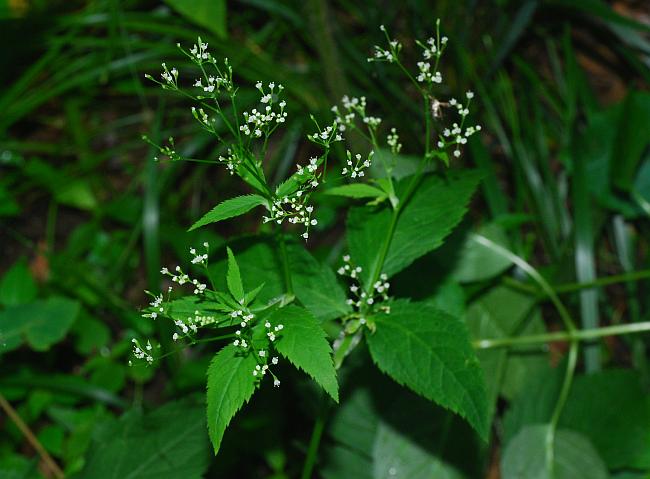Cryptotaenia canadensis (L.) DC.
Honewort

Native
CC = 2
CW = 0
MOC = 75
© SRTurner
Cryptotaenia canadensis (L.) DC.Honewort | |
 |
Native CC = 2 CW = 0 MOC = 75 |
© SRTurner |
|
Family - Apiaceae Habit - Fibrous-rooted perennial forb. Stem - Erect to ascending, to 1 m, often branched, glabrous. Leaves - Alternate, sometimes basal leaves also present at flowering, short- to long-petiolate, the uppermost leaves sometimes nearly sessile, the sheathing bases not or only slightly inflated. Leaf blades 3-13 cm long, broadly ovate, 1 time compound with 3 leaflets, the central leaflet sometimes with a pair of deep basal lobes, the lateral leaflets sometimes 1 or both with a single basal lobe, the leaflets or lobes 30-150 mm long, oblong-lanceolate to obovate, short- to long-tapered at the base, coarsely to finely, sharply and often irregularly toothed, often doubly toothed, tapered to a sharp point at the tip, glabrous.
Inflorescences - Terminal and axillary, compound umbels, often grouped into small panicles with ascending branches, mostly relatively long-stalked. Involucre absent or of 1 bract, this inconspicuous, shorter than the rays, spreading to ascending at flowering, linear, with a sharply pointed tip. Rays 2-7, 0.5-5.0 cm long, unequal in length, ascending. Involucel absent or of 1 or 2 bractlets, these shorter than the flower stalks, similar to the bracts.
Flowers - Flowers 2-10 in each umbellet, the stalks 2-30 mm long, unequal in length. Sepals absent or consisting of minute teeth. Petals obovate, rounded or with an abrupt, minute point at the tip, white. Ovaries glabrous.
Fruits - Schizocarps 4-7 mm long, narrowly oblong-elliptic in outline, narrowed at the base, tapered to a short beak at the tip, flattened laterally, glabrous, dark brown with lighter, greenish yellow ribs, the mericarps sometimes somewhat arched or curved, somewhat narrowed along the commissures, with 5 narrow, blunt ribs, these lacking wings.
Flowering - May - August. Habitat - Bottomland and mesic forests, streambanks, fens, moist shaded areas. Origin - Native to the U.S. Lookalikes - Broadly, Osmorhiza sp., Chaerophyllum sp. Other info. - This species is common across Missouri and the eastern half of the continental U.S. Its range ends abruptly at a nearly vertical line just west of Missouri. The plant is relatively inconspicuous. Look for smallish sprays of white "speckles" (the very small flowers) on a plant with broad leaflets growing in moist, shaded conditions. The entire plant is glabrous. It is probably most easily confused with species of Osmorhiza, but note the hairiness of that species. Photographs taken at Weldon Spring Conservation Area, St. Charles County, MO, 6-15-2011 and 6-2-2020, Glassberg Conservation Area, Jefferson County, MO, 5-26-2017, and at Young Conservation Area, Jefferson County, MO, 8-17-2020 (SRTurner). |